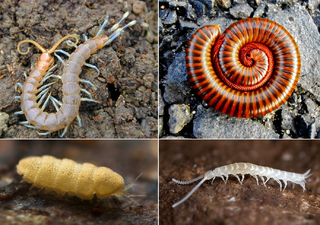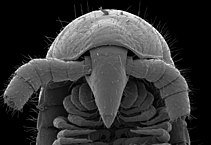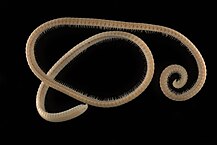
Millipedes are a group of arthropods that are characterised by having two pairs of jointed legs on most body segments; they are known scientifically as the class Diplopoda, the name derived from this feature. Each double-legged segment is a result of two single segments fused together. Most millipedes have very elongated cylindrical or flattened bodies with more than 20 segments, while pill millipedes are shorter and can roll into a tight ball. Although the name "millipede" derives from Latin for "thousand feet", no species was known to have 1,000 or more until the discovery in 2020 of Eumillipes persephone, which can have over 1,300 legs. There are approximately 12,000 named species classified into 16 orders and around 140 families, making Diplopoda the largest class of myriapods, an arthropod group which also includes centipedes and other multi-legged creatures.

Centipedes are predatory arthropods belonging to the class Chilopoda of the subphylum Myriapoda, an arthropod group which includes millipedes and other multi-legged animals. Centipedes are elongated segmented (metameric) creatures with one pair of legs per body segment. All centipedes are venomous and can inflict painful stings, injecting their venom through pincer-like appendages known as forcipules or toxicognaths, which are actually modified legs instead of fangs. Despite the name, no centipede has exactly 100 legs; the number of pairs of legs is an odd number that ranges from 15 pairs to 191 pairs.

Myriapods are the members of subphylum Myriapoda, containing arthropods such as millipedes and centipedes. The group contains about 13,000 species, all of them terrestrial.

Illacme plenipes is a siphonorhinid millipede found in the central region of the U.S. state of California. It has up to 750 legs. One of three known species in the genus Illacme, it was first seen in 1926, but was not rediscovered until 2005, almost 80 years after its discovery, by Paul Marek, then a Ph.D. student at East Carolina University.

Orator Fuller Cook Jr. was an American botanist, entomologist, and agronomist, known for his work on cotton and rubber cultivation and for coining the term "speciation" to describe the process by which new species arise from existing ones. He published nearly 400 articles on topics such as genetics, evolution, sociology, geography, and anthropology.

Polydesmida is the largest order of millipedes, with more than 5,000 species, including all the millipedes reported to produce hydrogen cyanide (HCN). This order is also the most diverse of the millipede orders in terms of morphology. Millipedes in this order are found in all regions of the world other than Antarctica.

Motyxia is a genus of cyanide-producing millipedes that are endemic to the southern Sierra Nevada, Tehachapi, and Santa Monica mountain ranges of California. Motyxias are blind and produce the poison cyanide, like all members of the Polydesmida. All species have the ability to glow brightly: some of the few known instances of bioluminescence in millipedes.

Siphonophorida is an order of millipedes containing two families and over 100 species.

Chordeumatida is a large order of millipedes containing more than 1,400 species. Also known as sausage millipedes, they are found nearly worldwide. Chordeumatida is the largest order in the superorder Nematophora, a group also known as spinning millipedes because their telsons feature spinnerets used to build nests of silk. These millipedes produce this silk to create chambers in which to molt or to lay their eggs.

Siphoniulus is a poorly known genus of millipede containing only two living species: S. alba from Indonesia, and S. neotropicus from Mexico and Guatemala. An additional two fossil species are known from Cretaceous amber. Siphoniulus species are the only members of the family Siphoniulidae and order Siphoniulida, making Siphoniulida the smallest millipede order. Few specimens are known, and their classification is contentious, although most recent studies place them as basal members of the Helminthomorpha.

Harold Frederick Loomis was an American botanist and myriapodologist known for his contributions to agronomy, plant pathology, and millipede taxonomy. He worked for the U.S. Department of Agriculture for over four decades, studying diseases of crop plants, and was a colleague of Orator F. Cook. He also made major contributions to the natural history of Central America and the West Indies, naming over 500 species of millipedes in total. He co-described with Cook the leggiest animal on earth: Illacme plenipes, with over 700 legs.

Geophilus hadesi is a species of soil centipede in the family Geophilidae. This centipede is a troglobite, spending its entire life cycle in a cave environment. This species and Geophilus persephones are the only two troglobites known in the order Geophilomorpha. The species G. hadesi is named after Hades, god of the underworld in Greek mythology and the husband of Persephone, the namesake of the first troglobite discovered among the soil centipedes. The species G. hadesi has been observed in a cave as far as 1,100 meters below the surface, the deepest underground that any centipede has ever been recorded.
Glomeridesmidae is a millipede family of the order Glomeridesmida. This family includes two genera: The genus Glomeridesmus includes most species in this family; the genus Glomeridesmoides includes one species.

Illacme is a genus of millipedes in the family Siphonorhinidae. It includes three species. Illacme plenipes was first described in 1928 from San Benito County, California, and rediscovered in 2005. In 2016, Illacme tobini was described based on a single male specimen collected in 2006 from Lange Cave, in Sequoia National Park, 240 km (150 mi) east of the known habitat for I. plenipes. In 2018, Illacme socal was discovered in Whiting Ranch Wilderness Park.
Geophilus persephones is a species of soil centipede in the family Geophilidae discovered in 1999. This species is named after Persephone, the queen of the underworld in Greek mythology, and found in caves in the Gouffre de la Pierre Saint-Martin. It has elongated antennae and legs as well as abundant sensory setae, and like other geophilomorhps it lacks sight, has a flattened trunk, and is well adapted to underground life. This species was the first troglomorphic geophilomorph ever discovered and one of the only two in existence along with Geophilus hadesi. Known from a single male specimen measuring 16.2 mm in length, G. persephones has only 29 pairs of legs, one of only two species in the Geophilidae family to feature so few leg pairs.

Illacme socal is a species of millipede in the family Siphonorhinidae. It was discovered in California at Whiting Ranch Wilderness Park in 2018.
Agenodesmus is a genus of millipedes in the family Fuhrmannodesmidae, which some authorities consider a junior synonym of Trichopolydesmidae. This genus is notable for being among the very few genera in the order Polydesmida to feature adults with only 18 segments rather than the 20 segments usually found in this order. The genus Agenodesmus contains only two species, A. reticulatus and A. nullus. The type species A. reticulatus is notable as the first polydesmidan millipede discovered with only 18 segments in adults, the smallest number recorded in the order Polydesmida. Before the discovery of A. reticulatus, polydesmidans were known to have only 19 or 20 segments in adults.
Devillea is a genus of flat-backed millipedes in the family Xystodesmidae. These millipedes are rare and limited to caves. Species in this genus are found in Sardinia, Capri, and southern France in the Maritime Alps. These species are notable for featuring more than the 20 segments usually found in the order Polydesmida. This genus is one of only two genera in this order to feature these extra segments and the first such genus to be discovered.
Lipseuma is a genus of millipedes in the family Kashmireumatidae. This genus contains only two species, the type species L. josianae and its close relative L. bernardi. Both species are troglobites found in caves in China.
Neocambrisoma is a genus of millipedes in the family Metopidiotrichidae. Millipedes in this genus are found in Tasmania and New South Wales in Australia. Like other genera in this family, this genus features 32 segments in adults of both sexes, rather than the 30 segments usually observed in adults in the order Chordeumatida. Accordingly, female adults in this genus have 54 pairs of legs, which is not only the maximum number observed in this order but also the maximum number fixed by species in the class Diplopoda.
















